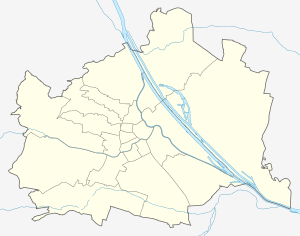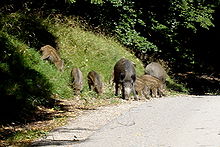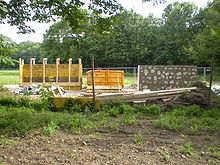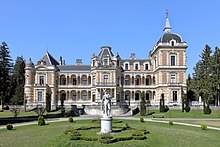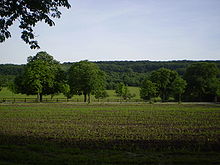Lainzer Tiergarten
| Lainzer Tiergarten | ||
|---|---|---|
| particularities | publicly accessible nature reserve | |
| place | Hermesstrasse 1130 Vienna |
|
| surface | 2,450 hectares | |
| opening | 1561 (fencing of the former hunting ground) | |
| Animal species | Deer , fallow deer , roe deer , European mouflons , wild boars , bats , Heck cattle | |
| Species focus | Wild | |
| organization | ||
| Sponsorship | Municipal Department 49 - Forestry Office and Agricultural Company of the City of Vienna | |
|
Lainzer Tor |
||
|
|
||
Coordinates: 48 ° 10 ′ 45 ″ N , 16 ° 12 ′ 26 ″ E
The Lainzer Tiergarten is a publicly accessible nature reserve in Vienna and partly also in Lower Austria , which is administered and looked after by Municipal Department 49 - Forestry Office and Agricultural Company of the City of Vienna . It is a zoo in the sense of an extensive forest area with rich wildlife that lives freely within the garden. As this protected area, it is also part of the Vienna Woods Biosphere Reserve . Most of the Lainzer Tiergarten is located in the west of Vienna, with a small part in the Lower Austrian municipality of Laab im Walde .
Location, size, goals
The Lainzer Tiergarten, named after the town of Lainz to the east , is largely located like this one in Hietzing , the 13th district in the west of Vienna, in the cadastral community of Auhof. The walled area slopes down north to the Wiental with the Auhof and the Westautobahn , borders to the north and east of urban settlement areas and to the west and south of forests in Lower Austria and Vienna up to Laab , and to the south also to the Liesingbachtal .
With the adjacent forests, the zoo is part of the northern part of the Vienna Woods . It is located on the eastern edge of the Alps, where a sea coast lay in the Miocene . There, references to the activity of a small volcano were found that were scientifically published. Volcanic rocks ( picrites , tuffs ) were found several times. Sea mussels have drilled holes in the rocks.
The total area of the Lainzer Tiergarten is currently 2450 hectares , of which 2360 hectares are in the city of Vienna. 1945 hectares are forest. The surrounding wall of the Lainzer Tiergarten is around 22 kilometers long. Entry to the zoo is only possible through gates that are open at different times depending on the season (clockwise):
- Lainzer Tor, 13th, Hermesstrasse, in the east; with a visitor center and nearby Hermes villa , the “main gate” of the zoo, open all year round; Bus line 56B from the Hietzing subway station , there connection to line U4 .
Gates that are closed in December and January:
- Gütenbachtor, 23., Gütenbachstrasse, in the south, bus routes 253, 254, approx. 30 minutes' walk
- Laaber Tor, in the southwest, municipality of Laab im Walde , bus route 253, Laab stop Tiergartenstraße, approx. 15 minutes' walk
- Pulverstampftor, in the north at Auhof , 14., Hofjagdstraße, bus line 50B, stop Auhof Umspannwerk on the parallel Wientalstraße
- Nikolaitor, in the northeast, 13th, corner of Nikolausgasse / Seuttergasse; near the train station Wien Hütteldorf , U4 and S-Bahn
- Sankt Veiter Tor, 13., Gemeindeberggasse, bus line 54A (formerly known as Sauzagltürl )
Animal population, nature conservation
The Lainzer Tiergarten has always been characterized by its abundance of game (strongly decimated in the post-war period). Deer , fallow deer , roe deer , European mouflons (horned wild sheep) and, above all, wild boar are among the many species of animals found there. A large variety of bats has also been identified.
The entire Lainzer Tiergarten is a Natura 2000 nature reserve and is home to some of the oldest beeches and oaks in the Vienna Woods. Trunks of up to four meters can be found. Most of these old trees can be found on Johannser Kogel . Due to the high number of wild animals in the park, there are many livestock biotopes that are otherwise very rare.
In the area between Lainzer Tor and Hermesvilla there are game gates and an arboretum , in which many of the local woody plants are shown.
The Lainzer Tiergarten is also designated as a single European reserve.
history
Use and conflicts of use until 1918

The first settlements on the Lainzer Tiergarten area go back to Roman times. In the course of archaeological excavations, ceramic fragments that were dated to the 2nd century AD were found. Other finds were assigned to the late 11th to 13th centuries. The Vienna Woods were used as a hunting area by the Babenbergers as early as the 11th century .
Emperor Ferdinand I bought the Auhof with the adjacent forests, had a wooden fence built around the area in 1561 and made it an imperial hunting ground (which it remained until 1918). The original fence only enclosed a small area of today's area and repeatedly required intensive repairs.
The reasons for the construction of the fence were the problems of browsing, game movement and foraging in fields and meadows due to the immediate spatial proximity to populated areas as well as the massive damage to the agricultural areas in the area. In addition, the protection of the vineyards and the separation of the spheres of interest of hunting and agriculture and wine management were a concern.
At the time of Emperor Charles VI. describes a contemporary publication the zoo as "the most elegant wildlife park in Europe". The hunting area in the Vienna Woods already had an above-average density of game compared to the natural population in the 18th century.
Increasing game damage in the vineyards led to patent Empress Maria Theresa as Archduchess of Austria of 25 August 1770 in which it the attitude of wild allowed only in closed zoos. The first plans for a permanent enclosure are dated October 10, 1770.
Under Emperor Joseph II , a wall was finally planned instead of the wooden fence, which should encompass a much larger area. Master builder Philipp Schlucker was commissioned to erect the 24.2 km long stone wall . However, this had miscalculated when calculating the construction costs and had to complete the wall between 1782 and 1787 for a fee well below the actual costs. From this incident the saying " poor swallower " is supposed to be derived. Part of the original Schlucker wall has been preserved right next to the powder pounding gate.
The legal institution of manorial rule ( Hans Kudlich's so-called peasant liberation), which was eliminated in the course of the March Revolution of 1848, led to various property disputes. The Saugarten, which had been in private imperial ownership for centuries and which was later given the name Tiergarten, became courtly property (state property reserved for use by the monarch) on August 26, 1855 by decision of Franz Joseph I. The area was still used almost exclusively for court hunts by the imperial family and their guests.
1882–1886 Franz Joseph I had the Hermesvilla built in the eastern part of the zoo, which is closer to the city, as a refuge for Empress Elisabeth . The zoo, which was less used for its actual purpose at the time, also due to Franz Joseph's decreased desire to hunt, was used differently for the first time. The Hermesvillapark is an area that still exists today, is completely planted, leveled and cared for by humans, which differs greatly from its surroundings in terms of its botanical and zoological features. The conflicts of use after this intervention in an almost undeveloped area did not fail to appear. The hunters complained about poaching and accused the construction workers of arson; the hunting and forestry work was suspended during the empress's stay in the zoo.
End of the Monarchy, War Vandalized Fund (1919–1937)
After the collapse of the monarchy at the end of the First World War in 1918, and with it the end of the imperial hunting ground, poaching and timber acquisitions took place in the zoo, against which the remaining hunters and foresters took action, albeit without noticeable success. Due to the lack of coal deliveries from abroad, the collection of "Klaubholz" was restricted. The illegal collecting and chopping of wood had to be contained by using force by the hunting and forest officials. Building materials and street lighting were also stolen.
The owner of the area was now the German-Austrian state or the Republic of Austria . It transferred the Lainzer Tiergarten, like many other former Hofärarian possessions, to the War Damaged Fund (KGF) on December 18, 1919 . Discussed changes in the use of the zoo - for example, the game population was to be limited to a small enclosure and the rest of the forest leased to farmers in order to counteract the deficit of the zoo - did not materialize. Agricultural and forestry use after the game population was shot down was also considered. The biggest threat for today's nature reserve was of various development plans, which have been implemented only to a small extent: In the city next part of the site, at the Hermes Street, the settlement was a city of peace built. (At the corner of Hermesstrasse / Linienamtsgasse, the former porter's house of the zoo is still to this day.) The fact that the zoo continued to exist as such was due to the nature conservation , which the Lainzer Tiergarten ecosystem considered worthy of protection.
In 1919 the zoo was temporarily opened to the public. The closing times caused a lack of understanding. Although the facility was only closed for the duration of the rut , the citizens felt that they were being treated unfairly and demanded that it be fully opened. The former hunting area slowly turned into a public park with the possibility of animal observation. Garbage problems and the demand for an inn on the site led to an intense dispute between conservationists and proponents of commercialization. This ended in 1925 with a half-hearted expansion of the “general description of forest in the forest management plant”. Closed seasons for wild animals have been introduced and flora and fauna are generally better protected.
In 1927, parts of the zoo were released for the construction of a golf course, which led to serious conflicts. The disturbance of the game, car traffic and the damage caused by the field as well as the plans to build hotels and tennis courts were the trigger. The problem disappeared of its own accord, however, as the club struggled with money problems and the use of the area was finally terminated in 1938, although the golf club formally existed during the war.
The murder that was committed on July 17, 1928 in Saulackenmais on the lady Katharina Fellner and went down in Viennese criminal history as "Murder in the Lainzer Tiergarten" caused a sensation.
The war victims' fund did not manage to generate surpluses for the war victims as expected. Its financial position was miserable, so that in 1929 the state took over all financial expenses such as taxes, pension payments etc. and the fund only managed the goods. The fund generated income from commercial hunting in the Lainzer Tiergarten, but was criticized for the changes in game behavior due to intensive hunting (“trophy shooting”). The economic crisis in the early 1930s led the Fund to become so indebted that it had to be liquidated.
The Lainzer Tiergarten went back into direct state ownership. The corporate state dictatorship transferred it in 1937 to the property of the then "federal" city of Vienna, although the area at that time still belonged to the state of Lower Austria .
Nazi era, post-war period (1938–1960)
On October 15, 1938, Greater Vienna was created by the Nazi dictatorship ; the zoo was now part of the city of Vienna and was located in the new 25th district, Liesing. Under the direction of Reichsjägermeister Hermann Göring , the use of the area changed again. On the one hand, an intensive agricultural use of the meadows was considered, on the other hand, the zoo was declared a representative hunting area of the city of Vienna and forestry use was severely restricted. In contrast to the Lobau , the zoo was only hunted to a limited extent. Goering was a hunting guest only once; The focus was on breeding and “blood refreshment” of the stock. In 1938 Göring suggested that the Lainzer Tiergarten should be declared a nature reserve; this took place in 1941.
By expanding agriculture, feed was to be made available for winter feeding of the animals, which required intensive ground care measures, machines and trained personnel. In 1943, parts of the meadows were released for grazing by a herd of cattle, and food for the population was also grown on the arable land. As agriculture intensified, logging decreased. The return of the forests to their original character, typical of the Vienna Woods, meant that the felling, especially of red beech, fell under the plan of the “Reichsstelle für Holz”. At that time the park was only accessible to the population on weekends.
After the invasion of the Red Army in April 1945, the game population was almost wiped out. The zoo's infrastructure was dismantled or destroyed, and non-ferrous metals in particular were considered treasures. Target practice contributed to the destruction of the landscape. Because of the food shortage immediately after the war, more grain was grown again in the area of the zoo and the forestry use increased, whereby the forest administration successfully opposed the use of high-quality wood for heating.
In 1954, NS-Greater Vienna was reduced to today's urban area. Liesing was now the 23rd district. In 1956 the Lainzer Tiergarten was separated from the 23rd district and incorporated into the 13th district, Hietzing, to which it still belongs to this day.
As after the First World War, other uses were discussed in the post-war period, but never realized. Such a large amount of unused land was seen by many as an unnecessary luxury and, as before, efforts were made to build on the area. According to the original plans, the route of the western autobahn was to be laid directly through the zoo. The dispute between supporters and opponents of this route threatened to escalate, but ultimately a compromise was reached. For the construction, parts in the north of the area near Weidlingau and Auhof were separated, but in 1960 new areas were incorporated at Laab im Walde as a replacement . This approximately 90 ha between the now functionless Old Dianator and the Laaber Tor are located in Lower Austria .
The sensitization of the population to nature conservation issues, supported by the media, led to increased criticism of the hunt, although the hunt for such an ecosystem is essential for its existence. The dangers for visitors from uncontrolled feeding of the wild boar and the associated loss of shyness of the animals were hardly an issue.
With the increase in visitor frequency, the need for rest houses increased: in 1959 the "Rohrhaus" was opened, in 1963 the "Hirschgstemm" opened.
In 2003 a monument, the Tenno Kogo stone , was erected.
Uses and conflicts in the present
The current forms of use in the area of the zoo differ considerably from those of the time it was founded. The density of game in the Lainzer Tiergarten is still high and exceeds the natural population by a factor of around 10, which requires intensive care and hunting in order to prevent excessive browsing on the forest fringes or the herbaceous and shrub layers. In addition, the settlement of predators is impossible for reasons of visitor safety and the limited size of the area. In order to protect guests of what is now the public park from possible damage caused by hunting, this is carried out during the closing times in winter. The game species hunted here are mainly wild boar, but also red deer and roe deer . In addition to these, fallow deer , mouflon and so-called Heck cattle are kept in their own enclosures .
In terms of forestry, the main focus is on the preservation and care of the stock, on the one hand to maintain and expand the diversity of species , and on the other hand to protect visitors from possible dangers. The Forestry Office of the City of Vienna ( MA 49) is responsible for all relevant work. From a botanical point of view, the park does not only offer original planting native to Central Europe. The park is not a primeval landscape , but a cultural landscape largely left to nature . The thinning is carried out at a very low level compared to the commercial forest , away from the paths, the forestry work is reduced to a minimum or stopped entirely. In the area of the Johannser Kogel, the - possibly not site-specific - old oak stock was not thinned and declared a natural monument despite the damage to the trees . In order to promote the natural character of the park, the use of heavy forest machines is kept as low as possible.
Agriculture is practiced in small parts of the area. However, the management of the meadows is of greater importance. These are shown on the one hand as storage meadows for recreational use and on the other hand as feeding meadows that are not allowed to be entered. The additional feeding during the winter months is largely carried out with green fodder harvested on these meadows. In principle, visitors are only allowed to leave the paths in areas that have been approved for this purpose.
Today, however, the zoo is mainly used as a local recreation area. In addition to the Hermesvilla as a culture and exhibition center, the area is particularly interesting for hikers and runners, families and day-trippers.
Even today, there are always conflicts of interest between visitors and those responsible. On the one hand, the park is designed as a nature reserve, which is supported by intervening as carefully as possible in the ecosystem, on the other hand it is a popular excursion destination and must therefore offer minimum requirements in terms of accessibility and infrastructure. The combination of both excludes the possibility of a natural protected area in the sense of a national park , which is not up for discussion anyway due to the centuries-old interventions in the ecosystem. In order to guarantee the most comprehensive protection possible, the Lainzer Tiergarten is part of the Vienna Woods Biosphere Park. Due to the number of visitors and to protect the visitors, extensive forestry and agricultural measures are unavoidable, for example the felling of rotten trees in the vicinity of the paths.
Since the park is a nature reserve, on the other hand, it is impossible to expand the infrastructural measures to such an extent that the Lainzer Tiergarten would be rededicated as a fully developed recreation and amusement area, with all the necessary interventions. The ban on motor vehicles, bicycles, skateboards and pets, the very limited number of parking spaces available, the ban on open fires and the restricted use of green spaces are certainly a recreational restriction compared to other local recreation areas such as the Vienna Prater or the Danube Island . Except for the Hermesvilla, the area is largely undeveloped, the streets and paths are partly unpaved, there are relatively few sanitary facilities available. On the other hand, these restrictions make up the specific quality of the park.
leisure
The Lainzer Tiergarten is a popular destination. The area is particularly suitable for walks (especially Lainzer Tor) and hiking. The well-paved network of trails is also ideal for runners, joggers and Nordic walkers (some are signposted running routes). The establishment of two nature trails as well as the opportunity to take part in guided tours and excursions under expert guidance expand the offer. A visitor center offers changing detailed exhibitions on aspects of nature conservation in the park.
The Wittgensteinstrasse car park is the starting point for the Planet Trail . Along the wall of the Lainzer Tiergarten there are information boards on the planets of the solar system with true-to-scale images and at true-to-scale distances.
It is not permitted to bring dogs into the Lainzer Tiergarten to protect the wildlife.
The Lainzer Tiergarten generally opens daily at 8:00 am and closes between 5:00 pm and 9:00 pm, depending on the season; From the beginning of November to the end of January, only the park of the Hermesvilla is accessible from 9:00 a.m. to 5:00 p.m. (In contrast to this, the entire zoo is also open during the Christmas holidays, but only Lainzer Tor, Nikolaitor and St. Veiter Tor are open.) Admission to the zoo (but not to exhibitions in the Hermesvilla) is free.
- Guest houses: Rohrhaus, Hirschgstemm, Cafe Hermesvilla.
- Museum in the Hermesvilla
- Hubertuswarte observation tower on Kaltbründlberg (508 m)
- Nikolaikapelle (first mentioned in 1321)
- Vienna view Baderwiese
literature
- Karl Johann Tichy, Hannes Mayer : The oak nature reserve Johannser Kogel in the Lainzer Tiergarten, Vienna Woods. Special print from Centralblatt for the entire forestry. Year 96. 1979, No. 4. Österreichischer Agrarverlag, Vienna 1979.
- Gabriele Gergely, Thomas Gergely, Hermann Prossinagg: From the Emperor's suction garden to the Viennese zoo. The history of the Lainzer Tiergarten - discovered in a forgotten archive. Vienna, Cologne, Weimar 1993.
- Hermann Prossinagg: Vienna and the hunt. In: hunting season. Austria's hunting history - a stalk. Vienna 1996, pp. 113–125.
- Gerd Pichler: New archival results on the medieval fortifications and the derelict settlement near the Nikolaikapelle in the Lainzer Tiergarten in Vienna. In: Find reports from Austria. 34, Vienna 1995, pp. 495-496.
- Gerd Pichler, Alice Kaltenberger, Michaela Müller: The Nikolaikapelle in the Lainzer Tiergarten in Vienna. Vienna Archaeological Studies, Vienna 4/2002.
Individual evidence
- ↑ Josef Stiny, Friedrich Trauth: The building site for the new water tank in the Lainzer Tiergarten . Yearbook of the Federal Geological Institute . Volume 88, Vienna 1938. Pages 35–48 ( PDF )
- ↑ An extinct volcano at the gates of Vienna. Daily newspaper "Reichspost" from November 7, 1937, No. 307/1937, page 9
- ^ Heinrich Küpper: On the knowledge of the Alpine breakup on the western edge of the Vienna basin . Yearbook of the Federal Geological Institute. 94th Volume Part 1, Vienna 1951. Pages 41-92. ( PDF )
- ↑ Der Fuchs vom Sauzagltürl on May 31, 2012, accessed on January 4, 2014.
- ↑ Where nature is at the center - protected areas in the Vienna Woods ( Memento of the original from April 23, 2010 in the Internet Archive ) Info: The archive link was automatically inserted and not yet checked. Please check the original and archive link according to the instructions and then remove this notice. on Lebensregion - Wienerwald Biosphere Park accessed on June 1, 2010
- ↑ Joh. Georg Mößle: Collection of all kk ordinances and laws from the years 1740 to 1780, which under the reign of Emperor Joseph II partly still existed, partly changed, as an auxiliary and supplementary book to the manual of all ordinances and laws issued for the Imperial and Royal Hereditary Lands under the government of Emperor Joseph II in a chronological order. Volume 6, Vienna 1786. Pages 273–275 ( ÖNB )
- ↑ Lainzer Tiergarten: Animals in the Lainzer Tiergarten
Web links
- Lainzer Tiergarten on the MA 49 website
- Lainzer Tiergarten : unofficial information collection of the zoo
- Vienna Museum in the Hermes Villa
- Website of the Vienna Woods Biosphere Reserve
- New ways for wildlife management in the Lainzer Tiergarten
- Documentation The Empress's wild forest on the 3sat website

